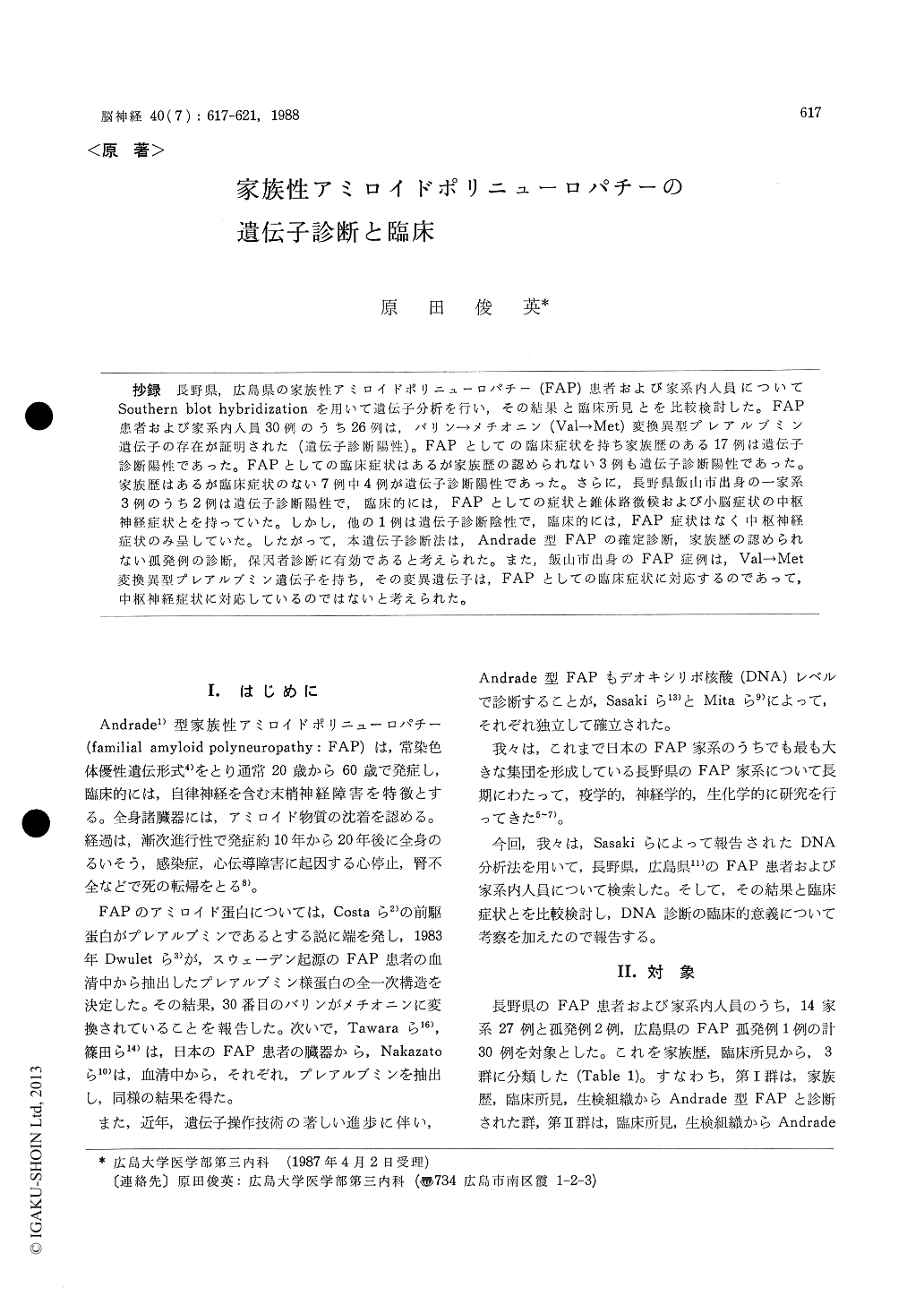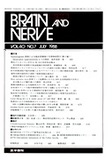Japanese
English
- 有料閲覧
- Abstract 文献概要
- 1ページ目 Look Inside
抄録 長野県,広島県の家族性アミロイドポリニューロパチー(FAP)患者および家系内人員についてSouthern blot hybridizationを用いて遺伝子分析を行い,その結果と臨床所見とを比較検討した。FAP患者および家系内人員30例のうち26例は,バリン→メチオニン(Val→Met)変換異型プレアルブミン遺伝子の存在が証明された(遺伝子診断陽性)。FAPとしての臨床症状を持ち家族歴のある17例は遺伝子診断陽性であった。FAPとしての臨床症状はあるが家族歴の認められない3例も遺伝子診断陽性であった。家族歴はあるが臨床症状のない7例中4例が遺伝子診断陽性であった。さらに,長野県飯山市出身の一家系3例のうち2例は遺伝子診断陽性で,臨床的には,FAPとしての症状と錐体路徴候および小脳症状の中枢神経症状とを持っていた。しかし,他の1例は遺伝子診断陰性で,臨床的には,FAP症状はなく中枢神経症状のみ呈していた。したがって,本遺伝子診断法は,Andrade型FAPの確定診断,家族歴の認められない孤発例の診断,保因者診断に有効であると考えられた。また,飯山市出身のFAP症例は,Val→Met変換異型プレアルブミン遺伝子を持ち,その変異遺伝子は,FAPとしての臨床症状に対応するのであって,中枢神経症状に対応しているのではないと考えられた。
Serum prealbumin variant with a substitution of methionine (Met) for valine (Val) at position 30 is known to be related to Andrade type familial amy-loid polyneuropathy (FAP). Recently, the diagno-sis of FAP by recombinant DNA techniques has been established. The DNA diagnosis is based on the fact that a nucleotide substitution responsible for Val-Met change results in formation of new restriction sites for Nsi 1 and Bal 1.
We conducted the DNA diagnosis studies of 30constituents of FAP pedigrees originated from Na-gano and Hiroshima Prefectures, and compared the results with clinical features. Clinical features of the patients originated from Ogawa Village area in Nagano Prefecture and from Hiroshima Prefecture showed Andrade type FAP such as polyneuro-pathy and autonomic nervous disorders. Those of the patients from Iiyama City in Nagano Prefecture showed central nervous involvement such as cere-bellar ataxia and/or pyramidal tract signs in ad-dition to the clinical features of Andrade type FAP (Iiyama type).
DNA prepared from white blood cells was di-gested with restriction endonuclease Nsi 1 or Bal 1 and subjected to Southern blot hybridization. The resulting DNA segments were fractionated by a-garose gel electrophoresis. The gel was alkalized to convert the double-strand DNA to a single-strand form, which then was absorbed on a nylon mem-brane filter. The prealbumin cDNA was labelled with 32) P as a probe. The probe was hybridized with DNA segments on a filter. The filter was placed on the X-ray film to obtain the autoradio-gram.
DNA of 26 patients and their families gave typi-cal bands for FAP (5.0 and 1.4 with Nsi 1,3.6 and 1.6 kb with Bal 1) besides normal prealbumin gene (positive DNA diagnosis), indicating that they had the Val-Met interchange variant prealbumin gene. Seventeen of 26 cases had clinical features charac-terized by Andrade type FAP and family history from Ogawa Village area. Three cases had clini-cal features of Andrade type FAP but no family history. Two of 3 cases were originated from Ogawa Village area and one from Hiroshima Pre-fecture. Four cases originated from Ogawa Village area had no clinical features of FAP but family history. Two cases originated from Iiyama City had clinical features of Iiyama type FAP.
Four cases who did't have the mutation had fa-mily history but no clinical features of FAP. One of 4 cases had only pyramidal tract signs and fa-mily history from the Iiyama type FAP pedigree.
These findings indicated that the presence of the variant prealbumin gene closely corresponded to the clinical features of Andrade type FAP. The DNA diagnosis was found to be valuable for the definite diagnosis of Andrade type FAP even in sporadic cases and presymptomatic cases. FAP patients originated from Iiyama City and Ogawa Village area were considered to have the same mutation despite the differences in clinical manifes-tations. We also postulated that the clinical fea-tures characteristic of Andrade type FAP were in-cidentally associated with central nervous involve-ment in the liyama type FAP patients. Not only the variant prealbumin gene but also some other factors might be related to amyloidogenesis of An-drade type FAP, because the onset, clinical course and clinical features were varied in each case with the same mutation in this study.

Copyright © 1988, Igaku-Shoin Ltd. All rights reserved.


